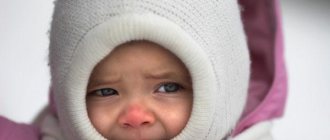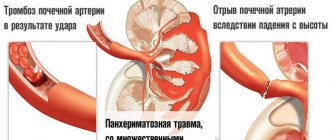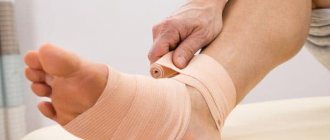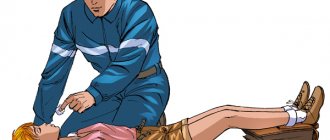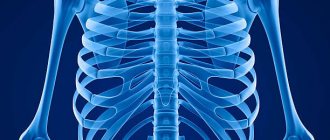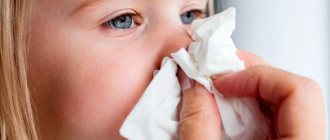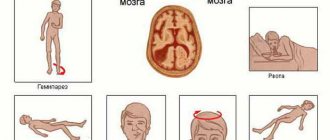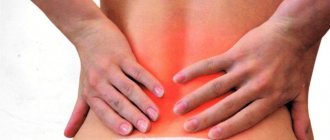State Autonomous Institution "Shilkinskaya Central District Hospital"
Frostbite occurs not only in winter, but also in spring and autumn, and even in southern latitudes.
Depending on the etiological factor, there are four main types of frostbite, differing in clinical and morphological picture:
- Frostbite from exposure to dry frost;
- Frostbite that occurs at temperatures above zero;
- Contact frostbite occurring at subcritical temperatures;
- Chill syndrome.
In most cases, frostbite affects peripheral parts of the body (face, feet, ears, nose, etc.).
The first place in the frequency of frostbite is occupied by 1 toe, in second place are the fingers. Mostly exposed or peripheral areas of the body suffer from exposure to low negative temperatures during dry frost. The cellular protoplasm is directly damaged, followed by necrosis or tissue degeneration.
With prolonged intermittent exposure to damp cold, which often occurs in spring, heat transfer increases. This leads to the development of so-called “trench foot,” which is a classic example of grade 4 frostbite at temperatures above zero. As a result of vasomotor and neurotrophic disorders, destructive changes can develop, including tissue necrosis, wet gangrene and sepsis.
Contact frostbite occurs when naked areas of the body (usually hands) come into direct contact with sharply cooled metal objects. Such frostbite is more often observed in wartime among tank crews, rocket crews, pilots, etc.
Chill is understood as a type of chronic frostbite of mainly exposed parts of the body (hands, face, ears, etc.), often arising under the influence of systematic, but mild and short-term cooling. People who have suffered frostbite in the past are most susceptible to chills. Clinically, chills are characterized by swelling, cyanosis, itching and paresthesia of the affected skin. In more severe cases, cracks and ulcers on the skin, secondary dermatoses and dermatitis may develop.
Classification of frostbite by degree:
- I degree: characterized by a disorder of local blood circulation and innervation without subsequent necrosis with a short period of decreased tissue temperature. The victim feels itching, burning pain, paresthesia in the affected areas. The skin is swollen, tense, and has a marbled pattern. All these phenomena disappear in the coming days, but the increased sensitivity of the affected areas of the skin to cold persists for a long time.
- II degree: frostbite is accompanied by swelling and necrosis of the skin. On cyanotic and edematous skin, blisters with transparent exudate form, which can appear several days after warming. The victim notes intense pain in the areas of frostbite, intensifying with increasing swelling; the treatment period for such victims is 3 weeks or more.
- III degree: long period of tissue hypothermia. Necrosis of the entire thickness of the skin occurs along with subcutaneous tissue. Flabby blisters with hemorrhagic contents may form on frostbitten skin. Subjective sensations are more intense and lasting. The skin is pale and cold to the touch. Dead tissue undergoes partial melting and rejection, which is accompanied by suppuration. The resulting defect heals by secondary intention within 30–60 days.
- IV degree: characterized by the longest period of tissue hypothermia and a sharp drop in local tissue temperature. All layers of soft tissue and bone die. The intensity of pain is very varied and does not correspond to the depth and extent of frostbite. Spontaneous rejection of necrotic tissue takes a long time and is often complicated by purulent infection.
First aid
First aid for frostbite in the latent period comes down to the speedy restoration of temperature and blood circulation in the affected tissues; to protect this, first of all, measures are taken to warm the victim. Wet clothes in an insulated room are removed and replaced with dry ones. The victim is warmed by all available methods: using heating pads, warm blankets, envelope bags, and given hot food and drink.
Restore blood circulation in frostbitten areas by rubbing them with cotton wool and alcohol or dry hands, combined with a gentle massage of this area. After warming and pinking of the skin, apply an alcohol or aseptic bandage with a thick layer of cotton wool. It is unacceptable to rub frostbitten areas of the body with snow, as this leads to additional cooling, due to the fact that the temperature of frostbitten tissue is much higher than the temperature of snow and, in addition, this is fraught with the danger of causing microtrauma.
If the situation allows, they actively warm the frostbitten limb in water, immersing it in water at a temperature no higher than 24 degrees, bringing it to 36-40 degrees within 20–30 minutes with simultaneous massage from the periphery to the center, combining it with active movements in the affected limb. After warming and restoration of blood circulation, an insulated aseptic bandage is applied to the limb. Do not lubricate the frostbitten surface with tincture of iodine, dyes, fats and ointments. This makes local observation of the skin and treatment of the frostbitten surface difficult.
Freezing occurs as a result of exhaustion of the adaptive mechanisms of thermoregulation, when the body temperature, under the influence of external cooling, progressively drops, and all vital functions are inhibited until they completely disappear.
As with frostbite, there are two periods in the development of the freezing process: latent and reactive.
Latent period: drowsiness, lethargy, slowness of reactions, speech, movements, and general body tremors predominate. Then comes clouding of consciousness and loss of consciousness, convulsions, stiffening of the muscles, progressive slowdown, weakening and disturbance of the rhythm of breathing, cardiac activity, followed by clinical death. The most important symptom is a drop in temperature in the rectum below 35 degrees. The real threat of death occurs when the temperature in the intestine drops below 25 degrees.
Reactive period: occurs after the body as a whole has warmed up. During this period, various pathological processes may develop in internal organs (pneumonia, nephritis, etc.) and disorders of the nervous system (neuritis, paralysis, trophic lesions, mental and nervous diseases, etc.).
The most important feature of freezing is its phase nature, which clinically manifests itself in the form of three symptom complexes based on rectal temperature indicators.
Adynamic phase . Characterized by a decrease in temperature to 35–32 degrees. In the initial period of temperature decrease, all vital functions of the body increase, the frequency and depth of breathing increase, the pulse quickens and blood pressure and blood flow speed increase, metabolism and oxygen consumption by the body increase. Then there is a decrease in body temperature, accompanied by a drop in basic vital signs. The frequency of breathing and heartbeat decreases, consciousness is depressed, reactions slow down, speech constraint, drowsiness, etc. appear.
Stuporous phase . It should be considered a protective inhibition of the cerebral cortex spreading to the underlying parts of the central nervous system. When the temperature drops to 26–27 degrees, basic vital functions are suppressed. The respiratory and pulse rates slow down, the strength of heart contractions weakens, hypoxia and hypoxemia increase, and trembling stops. Severe muscle rigidity, urinary and fecal incontinence develop. Mental activity is completely suppressed.
Convulsive phase . It occurs when the temperature drops below 26 degrees and is characterized by the extinction of all vital functions. Metabolism sharply decreases and the supply of oxygen to tissues is disrupted. Cardiac activity weakens, blood pressure disappears. The rhythm of breathing is disrupted and it stops. Muscle tone and muscle rigidity disappear. In the final phase of development of extreme inhibition, parabiosis and paralysis of the central nervous system, all vital functions fade away, and clinical death occurs.
The main task of emergency treatment for severe freezing (stuporous and convulsive phase) is rapid active warming, aimed at quickly restoring the normal level of human body temperature.
Passive warming (wrapping up in a warm room, etc.) of such victims should be considered a fruitless waste of time. Fear of the negative consequences of rapid active rewarming is unfounded. The only danger is overheating, which can cause serious consequences even with a slight increase in body temperature. Therefore, rational measures of active warming should ensure the fastest return of body temperature to normal levels and at the same time prevent the danger of overheating.
To actively warm a victim in a stuporous or convulsive phase, it is necessary to place him in a warm bath with water at an initial temperature corresponding to body temperature, but below 22–24 degrees. Within 10–12 minutes, the water temperature is brought to 36–40 degrees and maintained at this level. It is advisable to carefully rub the body with soft washcloths in the bath, which helps restore vascular tone and reflex activity of the nervous system. If the victim's breathing increases to at least 12 per minute, he is taken out of the bath and connected to a ventilator, while simultaneously carrying out the entire range of conservative therapy.
Intravenous administration of glucose solutions with insulin, low-molecular blood substitutes, novocaine and other solutions heated to the victim’s body temperature, as well as the administration of heparin and hormones, are effective.
First medical aid to those who are frozen should be provided as fully as possible, including all methods of actively warming the victim. In the absence of such conditions, it is necessary to urgently evacuate them, taking measures to prevent further heat loss from the body during evacuation.
At the stage of qualified medical care, all frozen people are divided into three groups:
- The first group will include lightly injured people in the adynamic phase, who, after warming and treatment, will be left on the recovery team.
- The second group consists of those who are frozen in a state of moderate severity in a stuporous state, who are taken on stretchers to medical stations, where they are given active warming, after which, in accordance with the indications, they are distributed to functional units, where complex therapy is carried out.
- The third group includes seriously injured people who are in the convulsive phase, who are also warmed up, but more often they use artificial respiration, cardiac massage, etc.
After recovery from a serious condition in the reactive phase, the victims are evacuated to the stage of specialized care for follow-up treatment.
Frostbite in children is far from uncommon. Among the most common frostbites in children is iron frostbite. Children love to see if their tongue sticks to the door handle. In this case, you need to pour warm, but not hot water on the tongue stuck to the iron. If there is a wound, you need to see a doctor.
To prevent accidental frostbite in your child, be sure to wear mittens. You should be careful when walking outside in the cold:
- do not push your child on a swing;
- Do not allow climbing on metal equipment;
- do not give a spatula with a metal handle;
- metal parts of the sled need to be wrapped in a blanket.
REMEMBER that babies' bodies are not yet accustomed to regulating heat exchange, so young children are most prone to frostbite. Even at 0°C, infants can get frostbite. Older children can also get very cold without moving, after standing or sitting outside for a long time. Don’t forget that wet clothes are an additional factor in frostbite. Children can sweat from excess clothing or playing snowballs or other outdoor games. The areas most accessible to frost on a child’s body are: cheeks, chin, fingers, nose, ears. If frostbite occurs on the legs, you need to carry the child in your arms, and not force him to run or knock his legs to warm up.
Frostbite in children can be identified by the following signs:
- pale, cold skin with goosebumps or white patches;
- shiver;
- drowsiness or excessive talkativeness;
- difficulty pronouncing words, abruptness of speech;
- the skin loses sensitivity and becomes hard to the touch;
- body temperature is about 35°C.
For mild frostbite, place the child in a warm bath with a temperature of 36–37°C and bring it to 40°C within 40 minutes. Gently massage parts of the body. After the bath, we dry the baby, apply bandages made of gauze, cotton wool and cellophane, and wrap it in woolen cloth. If frostbite occurs on your fingers, you should definitely place strips of bandage between them. Give your child hot milk or tea.
Choose clothes and shoes for children from high-quality materials that will not allow your child to get wet and freeze. No need for thick overalls. The child should not sweat in it. It is better to buy thermal underwear and wear from -15°C. Shoes and gloves must be waterproof.
It would be good for everyone to know in advance how first aid for frostbite is carried out, but let it not be useful to anyone. By the way, dear women, in severe frosts it is better to avoid wearing earrings, rings, even gold and silver ones.
Be healthy!
Prevention of frostbite
Warming creams
- protect skin at temperatures up to – 50°C;
- resistant to temperature fluctuations;
- shelf life up to 30 months;
- support the skin's natural ability to retain moisture;
- accelerate natural skin regeneration
- do not contain water.
Warm clothes
- dress in several layers - layers of air retain heat;
- wear warm insoles and woolen socks - they absorb moisture, leaving your feet dry;
- do not go out into the cold without warm mittens, a hat and a scarf;
Risk factors for frostbite
- tight and wet clothes and shoes
- weakness, fatigue
- problems with blood vessels
- alcohol intoxication
Diagnosis of frostbite toes:
Before entering a warm room from the cold, tap the toe of one foot on the heel of the other. If the tips of your toes don't feel anything, you have frostbite.
For frostbite:
When indoors, remove damp or holey shoes (do not remove dry ones);
Insulate your feet from heat and wrap them up additionally. This is necessary to warm the body with internal heat, otherwise damaged tissues will be destroyed;
Drink 3-4 glasses of warm sweet tea to warm up from the inside;
If internal warming is accompanied by acute pain, take 2-3 tablets of analgin (in the absence of allergic reactions).
Be sure to consult a doctor for medical help!
When working at low temperatures:
At least once an hour, take off your gloves and check your fingers;
Pay attention to your colleagues and ask them to look at your face.
Frostbite of the nose, ears and fingers is often not noticed by the victim due to loss of sensitivity.
If you notice patches of white skin:
- Rub your palms until you feel warm;
- Place a warm palm on the area of whitened skin; on the nose, cheek or ears for 2–3 minutes;
- Repeat this procedure until the skin turns pink;
- Wrap yourself in a scarf, handkerchief, mitten or hat;
- Go into a warm room as quickly as possible and drink a warm, sweet drink.
Attention! Do not rub frostbitten skin, lubricate it with oils or Vaseline.
Don't be careless about suffering from the cold!
Winter now seems to be in no hurry to come into its own. There are no bitter frosts yet, chilling the blood and soul, especially those who love warmth, cold weather. But does this mean that there is no danger that awaits everyone who inadequately assesses the situation and freezes their legs, arms, nose or ears? These are the parts of the body that are first exposed to cold. Already at three degrees below zero, a person can pay for his carelessness. This is facilitated, first of all, by air humidity and wind, as well as poor body protection with clothing and tight shoes. Despite the seemingly “safe” weather in the department, a third of the patients are already suffering from severe frostbite, which requires surgical intervention. And how many patients receive outpatient treatment!
Among those who sought medical help, many were injured again. The fact is that areas of the body once exposed to frostbite become very sensitive to cold. And mostly these are young people who prefer force to health - short skirts, tight jackets, trousers, gloves, thin tights and tight dress shoes.
People who do not work, drink, or lead a wild lifestyle are also at risk. An important role in determining risk factors is also played by the physiological state of a person: old age, exhaustion, anemia, vitamin deficiencies, depressed state of the nervous system.
Against the background of frostbite, disability occurs. — Fingers and toes are amputated, ears are disfigured. But the most serious consequence is disease of blood vessels and nerve endings, chronic diseases leading to infertility.
The first signs of frostbite are sharp stabbing pain, discoloration of the skin and the inability to use a limb. General freezing is expressed in profound changes in all tissues of the body due to the gradual cessation of blood circulation and the ensuing anemia of the brain.
The very first first aid is to isolate the victim from the ongoing effects of low temperature, actively warming frostbitten limbs and body parts.
First of all, the victim must be wrapped up, a heat-insulating bandage applied to the affected area of the skin and sweet hot tea given - this will improve blood circulation.
You cannot do a massage, although a gentle one - light rubbing (preferably with a woolen cloth) is possible, but not with snow.
Taking a hot bath at home is dangerous, since sudden heating kills small vessels on the phalanges, which leads to tissue necrosis. There were many such cases in the practice of doctors.
Pain management is already under the control of doctors.
You cannot delay hospitalization. If treatment is started on the first day, the results are good.
It is very important to follow simple prevention rules to prevent frostbite. Dressing for the weather is a good idea. Not drinking alcohol before going out is two things. And three - know the first symptoms of frostbite, periodically warm up, and move actively.
The more complete a person’s body and its neurovascular system are, the better the nutrition and composition of the blood, the better protected it is by warm clothing and appropriate shoes, the more hardened it is, the more likely it is not to suffer from the cold.
Clinic from scratch
Who among you has never forgotten gloves or mittens in winter and left the house without them, and then tried to warm your hands under warm water? Even though spring is already close, the topic of frostbite is still relevant, especially for young children, because their skin is much more delicate than the skin of adults. In conditions of high humidity and wind, frostbite is possible even at above-zero temperatures. This is something to consider when getting your baby ready for a walk. Today we will learn what frostbite is, find out their degrees, and also talk about the prevention and treatment of frostbite in children.
Frostbite (or frostbite) is damage that occurs when locally exposed to low temperatures. Irrational clothing contributes to the occurrence of frostbite. Most often, protruding areas are affected - ears, nose, chin (usually as a result of exposure to low temperatures and cold air).
Occasionally, children may experience frostbite on the lips and tongue, which occurs when trying to lick very cold metal objects. Complaints: the presence of pale, “numb” areas of skin that have lost sensitivity.
The main task of parents when children spend a long time on the street, on the way to kindergarten or school, is to monitor how the child is dressed. Frostbite occurs more often in children and is more severe than in adults. This is due to the fact that the subcutaneous fatty tissue, blood vessels and nervous system of a child, especially of preschool age, are still in the process of formation and growth, and cannot fully withstand the cold. Therefore, all parents are recommended to check how and what they are wearing before letting their children go for a walk.
Children of preschool age cannot yet make complaints on their own, so parents need to pay attention to lethargy, increased body temperature, paleness or redness on the ears, cheeks, fingers and toes, calves, knees, as well as on the external genitalia in boys.
Older children complain of pain in the area of frostbite, tingling, burning sensation, redness, and lack of sensitivity.
During frostbite, two periods are distinguished: the period of local tissue hypothermia, or areactive (before rewarming), and the reactive period (after rewarming). In the period before warming up, those affected feel a feeling of cold, tingling and burning in the frostbite area, then a complete loss of sensitivity occurs. The affected area has a characteristic appearance: the skin is pale or bluish, the limb is not capable of active movements, and gives the impression of being petrified. During this period, it is impossible to determine the extent and extent of tissue damage, since there are no signs of inflammation in them and they seem viable. In the second period, after warming up, swelling quickly develops in the area of frostbite, and then inflammatory or necrotic changes are gradually revealed, so that the true severity of frostbite can be determined only after 10-15 days. Frostbite (or frostbite) is tissue damage caused by exposure to low temperatures.
There are several periods in the development of frostbite in children:
Pre-reactive period - or latent period. Occurs outdoors when exposed to low temperatures. The skin at the site of the lesion becomes very pale. During this period, it is impossible to determine the degree of frostbite. Its danger lies in the fact that the longer the latent period lasts, the more tissue is affected.
Reactive period. It begins from the moment the tissues are warmed. The child experiences pain in damaged tissues. The skin changes from pale to red or cyanotic (turns blue), tissue swelling is observed, and sensitivity is impaired. During this period, it is already possible to determine the degree of frostbite.
Let's consider the classification of frostbite in children:
Grade 1 - redness and slight swelling of the affected area are observed. Symptoms at this degree are as follows: burning, itching, loss of sensitivity, pain. After a few days, the symptoms disappear even without treatment, and slight peeling of the skin is observed.
2nd degree - in the affected area there is the appearance of a bubble with transparent or whitish contents, the skin around the bubble is white, sensitivity is reduced. The child often has a fever, chills, and weakness. At this and further stages, treatment is carried out only under the supervision of a doctor.
3rd degree - the frostbitten area is a bubble with purple-bluish contents, around which a demarcation shaft is formed (a ring separating dead necrotic tissue from living ones). Severe swelling is also noted. With this degree of frostbite, all layers of the skin are affected and gangrene may develop if the wound becomes infected. The skin is completely insensitive to the pain of a needle prick.
Grade 4 - characterized by necrosis of all tissues, including bones. The demarcation line appears only by the second week, and the entire affected area becomes clear. The skin at the site of frostbite is black, there is complete absence of sensitivity, and there is no pain. Recovery occurs after 2-3 months.
It is well known that frostbite does not occur without cold. However, it has been established that at an ambient temperature of +16°C, unprotected skin begins to rapidly lose heat, and at temperatures from +15 to -21°C, under conditions of high humidity and prolonged exposure to this temperature, frostbite is possible.
All factors contributing to the occurrence of frostbite are divided into four groups:
- meteorological - high humidity, strong wind, sudden and rapid change in air temperature;
- mechanical, impeding blood circulation in the limbs - tight clothing and shoes;
- contributing to a decrease in local tissue resistance - previously suffered frostbite, excessive flexion and immobility of the limbs, local disease of the limbs;
- causing a decrease in the overall resistance of the body - injuries and blood loss, acute infectious diseases, exhaustion and fatigue, hunger, disorders of consciousness, alcoholism, excessive tobacco smoking, and physical developmental deficiencies.
The role of alcohol intoxication is not only to turn off or reduce consciousness, impair motor activity, underestimate the danger of cold, etc., but also to reduce the body’s sensitivity to the effects of cold, i.e. the influence of alcohol is diverse. Other factors contributing to the occurrence of frostbite are insufficient attention to clothing in low temperatures and lack of alertness when the first signs of frostbite appear. Be that as it may, a healthy, warmly dressed, well-fed and active person, even at extremely low temperatures, is able to withstand their effects.
What to do if a child has frostbite
- In case of frostbite, it is necessary to stop the effects of cold on the body as quickly as possible - take the child with a frostbitten area of skin home.
- At home, carefully remove cold clothes from your child.
- You can warm frostbitten limbs in baths. The water in them should gradually change from +20 to +37⁰ The water should not be hot. If your nose or ears are slightly frostbitten, you can gently and gently massage them with your fingertips to restore blood supply.
- Remember that from the moment the tissues are warmed, pain appears, so try to calm the baby down, explain to him what is happening, be gentle, he is already feeling bad.
- Apply a dry thermal insulating bandage to the damaged area of the skin (bandages with cotton wool - a bandage, a layer of cotton wool, then a bandage again so that the cotton wool does not move out, put an oilcloth on top. Each layer should be larger than the previous one), secure on top with a woolen cloth.
- If a limb is frostbitten, it is necessary to immobilize it - that is, to ensure immobility. If you do not know how to apply splints, just make sure that the child does not move the limb, because An incorrectly applied splint will only worsen the situation and cause pain to the child.
- It is recommended to provide general warming to the patient - warm drinks, warm clothes.
- When providing first aid to your child, immediately call an ambulance, because only a doctor will be able to correctly determine the degree of frostbite and adjust further measures.
- With second, third and fourth degrees of frostbite, the child is taken to the hospital, so be prepared for this!
In no case should you do the following if you have frostbite:
Do not rub the frostbitten surface with snow! Snow causes damage to the capillaries of the skin, which will further worsen the recovery processes of the frostbitten area of the skin.
So-called rapid warming should not be used. Those. apply heating pads to frostbitten areas, bring the child close to the fire or fireplace, warm the child in hot water.
Do not rub oils, fats, or alcohol into damaged skin! All these methods for degrees 2-4 frostbite greatly aggravate the course of frostbite, and since it is impossible to immediately determine the degree of frostbite, refrain from such methods until the ambulance arrives.
Frostbite can happen to anyone, but it's best to follow a few simple rules to prevent it.
Feed your baby before going outside. Hunger = lack of energy in the body = inability to maintain body temperature at low temperatures = rapid cooling of the skin.
Clothing: main rules
- A sufficient minimum! If you can do without some kind of padded jacket, do without. Develop in your child the habit of dressing himself - choosing the number of things to wear. Colds often occur not from hypothermia, but from excessive sweating caused by excess clothing.
- “Walking without a hat causes meningitis” is a typical example of a folk tale. Meningitis is an acute infectious disease. In 99% of cases it is caused by a microbe called meningococcus. The likelihood of encountering a microbe does not depend on what is on your head at that time.
- In the vast majority of cases, the child says “I’m cold” due to the fault of the parents. After all, putting three fur coats on him and chatting with girlfriends (friends) is much easier than going for an active walk (running, playing).
- There is absolutely no point in covering your mouth with a scarf. Not a single scarf can even come close to matching the mucous membranes and sinuses of the nose in its ability to warm the inhaled air.
The child's winter outerwear should be made of waterproof fabric, because... If the clothes are wet, the child quickly freezes.
It is also better to purchase mittens with a waterproof outer fabric and/or you can take spare mittens with you and change them after the game before going home. You should choose a hat so that the child’s ears are completely and securely covered! When buying a hat, ask your child to shake his head, because... When playing outside, hats often slide to the side and ears open up.
The baby's shoes should not be too tight, but must have a warm insole. In severe frost, it is better to wear woolen socks under boots, because... Wool absorbs moisture well, while keeping the legs dry. But you should take into account the temperature outside, otherwise the baby’s feet will first sweat and may freeze due to the increased humidity.
In windy weather, reduce the time you walk with your baby (the wind helps to cool the baby faster). Before going out, you can use a special protective baby cream for frost.
While walking, watch your child’s face, ears, and hands. At the slightest sign of hypothermia (pale skin), go home immediately.
Upon arrival home, check all the child’s skin for frostbitten areas. Advanced frostbite can lead to gangrene, and subsequently amputation.
You need to go for a walk in any weather, the main thing is to know when to stop and not stand still, but play outdoor games.
Treatment of frostbite is different in the period before and after rewarming. In the first period, it is necessary to quickly stop exposure to external low temperatures and warm the victim’s entire body. For this purpose, the victim is placed in a bath at a water temperature of 37-40°. He should remain in the bath until the body temperature rises to normal (in case of freezing) and a feeling of thermal comfort occurs. If frostbite is not accompanied by symptoms of freezing, the patient can be warmed in a warm room, immersing only the affected limbs in warm water (t° 37-40°). When warming up, you should carefully and gently massage the frostbitten areas. The massage is performed with cleanly washed hands, disinfected with alcohol, or wearing sterile gloves. If blisters have already formed or areas of necrosis are found, massage is not performed. After warming, the skin is treated with alcohol and a sterile insulated bandage is applied to the frostbitten areas. For all types of frostbite, it is necessary to administer a prophylactic dose of antitetanus serum (3000 AE) and tetanus toxoid (0.5 ml). Previously, those vaccinated against tetanus were given only toxoid, without serum.
A serious mistake is rubbing frostbitten limbs with snow or immersing them in ice baths. This does not lead to the warming of frostbitten hands or feet, but to their further and very intense cooling. In the following days, treatment is carried out depending on the severity of frostbite. For frostbite of 1st and 2nd degree, treatment is only conservative - toilet; aseptic dry dressings. Bubbles, if they are not damaged, cannot be cut or opened; in case of opened, suppurating blisters, the exfoliated epidermis should be removed. In case of frostbite of the 3rd degree, conservative treatment is continued until the dead skin areas are rejected, in case of frostbite of the 4th degree - until the true severity of frostbite is revealed. Bandages with weak antiseptics (for example, Vishnevsky ointment) are placed on festering and granulating surfaces.
Surgical treatment is indicated for grade 3 frostbite and consists of plastic replacement of granulating defects formed after rejection of the dead area through skin grafting (autoplasty). With grade 4 frostbite, amputation is inevitable. Along with local treatment, for any degree of frostbite, the patient needs increased nutrition, the introduction of increased amounts of proteins and vitamins. According to indications - cardiac medications, antibiotics.
- Early:
- nails falling off,
- development of dry and wet gangrene,
- sepsis due to infection,
- amputation.
Late (distant), difficult to treat, requiring the involvement of a neurologist, phlebologist, or orthopedist:
- increased reaction to cold, cyanosis (blue skin);
- blood flow disorder, sclerotic changes in blood vessels, trophic lesions;
- bone atrophy, arthritis, polyneuritis, arthrosis, joint contracture;
- endarteritis with obliteration (vascular obstruction) of the lower extremities;
- Raynaud's syndrome.
Protective balm against wind and cold Weleda
This brand has long and reliably proven itself among other children's products, and needs no introduction. The big plus of this cream is that it does not contain water. This means that you don’t even have to wait the required 15-30 minutes before going outside, but immediately dive into the cold without fear of redness and chapping. Beeswax and skin-related lanolin in the cream form a protective cover, allowing the skin to breathe. The extract of calendula flowers eliminates inflammation on the skin, and almond oil increases the elasticity and protective properties of the skin. The balm is especially recommended for babies whose skin needs protection from the weather, and children with inflamed skin. Suitable for adults with sensitive skin.
Cryoprotector from Mirra Lux (Kutelitsa)
An excellent cream that is suitable for both children and adults. It enhances capillary blood circulation, and also nourishes, moisturizes and improves skin elasticity. The cream has a good natural composition and a pleasant smell of herbs and essential oils. It is good to smear on your hands, face and neck during outdoor winter sports and long walks. The composition contains water, so you need to apply it in advance. The composition also includes cedar, castor and milk thistle oils, extracts of propolis, nettle, ginseng, green tea, urea, glucose, beta-carotene, vitamins E, F, C. In general, you can safely take it.
Nourishing cold cream from Avene
Cream for dry and atopic skin, suitable for infants, children and adults. The texture is quite heavy, but it protects against frost perfectly! It does not contain fragrances or parabens and is generally ideal for those unfortunate people who are allergic to frost and bad weather.
Chicco Baby Moments
This product forms a protective film on children's skin, but is not at all sticky or greasy, and does not allow wind and frost to damage delicate cheeks. Does not contain dyes, alcohol, parabens and is safe for babies. Pleasant aroma, delicate consistency. A wonderful savior during walks in windy autumn and frosty winter.
Cream for wind and bad weather from Bubchen
The cream reliably protects even the most sensitive skin, providing it with protection from adverse weather factors. Vitamin E additionally supports cell functions, chamomile extract has an anti-inflammatory, antibacterial effect, soothes, softens and moisturizes the skin. When going for a walk with your baby, 30 minutes before going outside, simply apply “Cream for Wind and Bad Weather” on exposed areas of the body, and you will no longer be afraid of any bad weather.
Morozko from Avant
Perhaps the most affordable of our entire list, but no less effective. Yes, it happens that it is not suitable for some children, especially those who are severely allergic to cold, but for the majority it is very suitable. The only downside is the parabens and mineral oils in the composition, which are not very suitable for children's skin. But if the advice of experienced mothers is important to you, and not the composition, then you can safely buy it. It's at least worth a try.
Cream against wind and bad weather, SANOSAN.
Contains white wax, sweet almond oil and avocado oil. Intensively protects exposed skin in any weather from chapping and redness.
Baby walking cream, Bella baby Happy natural care
Cares, protects and strengthens the skin's natural protective barrier. Contains olive oil, which protects baby's sensitive skin from adverse weather conditions, as well as shea butter, which neutralizes the negative effects of sunlight.
Multi-regenerating product for sensitive and irritated skin Cicaplast balm B5, La Roche-Posey.
Instantly reduces discomfort caused by irritation thanks to the content of panthenol, La Roche-Posey thermal water and shea butter. Contains antibacterial components. Suitable for babies.
Mustela Bebe Cold Cream.
Quickly absorbed, provides long-lasting hydration and restores the protective mechanisms of damaged skin. Eliminates the effects of unfavorable climatic conditions, leaving the skin soft and velvety.
In conclusion, it is worth saying that frost is not a reason to stay at home. It is important to follow some rules, and most importantly, do not stand still while walking and play outdoor games, and then no temperatures will be terrible.
Publications in the media
Frostbite is tissue damage caused by local exposure to atmospheric cold or due to contact of the skin with extremely cold objects. The pathological process is often localized on the lower extremities, less often on the nose, ears and fingers.
Risk factors • Dehydration • Brain dysfunction • Circulatory disorders (due to cardiovascular diseases [including Raynaud's phenomenon], polycythemia) • Alcohol and drug use • Concomitant psychiatric disorders • Smoking • Elderly and children .
Classification • I degree - the skin is pale (sometimes cyanotic), edematous. Pain, itching, paresthesia, and aches in the joints of the affected area disappear on their own after 5–7 days. Later - increased sensitivity to cold of the affected areas • II degree - blisters with serous exudate appear on hyperemic or cyanotic skin (necrosis of the epidermis to the basal layer), leaving no scars or granulations. Healing usually lasts 2–3 weeks • Stage III - at the beginning of the reactive period, blisters with hemorrhagic exudate appear. Later, necrosis of the skin and subcutaneous tissue occurs. The skin becomes dark red, and subsequently a black scab forms. There is no pain sensitivity. After rejection of necrotic areas, granulations and scars remain. Healing lasts 1–3 months • IV degree - necrosis of all layers of skin, underlying soft tissue, bone. The skin is bluish in color, sometimes small blisters with hemorrhagic exudate appear. There is no pain sensitivity or capillary bleeding. Rejection of necrotic areas is delayed for several months and is usually complicated by wet gangrene and other purulent complications (cellulitis, tendovaginitis, osteomyelitis), sometimes tissue mummification occurs. Pathogenesis • Structural and functional disorders (spasm) of small blood vessels, tissue cells, nerves and skin • Dehydration, activation of lysosome enzymes and cell death • Damage to underlying vessels, muscles, nerves.
Clinical picture • Latent (pre-reactive) period •• Clinical manifestations are mild ••• Loss of sensitivity ••• Pallor or cyanosis of the skin ••• Thickening of the tissues of the affected area of the skin •• The depth of the lesion cannot be accurately determined • Reactive period •• Signs of inflammation appear • •• Swelling ••• Pain ••• Hyperemia ••• Necrosis in the frostbite zone •• The depth of the lesion is established 2-3 days from the moment of frostbite.
TREATMENT First medical aid • The victim must be taken to a warm room, change wet underwear and shoes, give a hot drink • A heat-insulating bandage must be applied to the affected area of skin • Rubbing the frostbite area with a soft cloth or hand (but not snow) • Warming the frostbitten limb in warm water (not higher than 40 °C) for 30 minutes • Transport immobilization of the affected limb. Drug therapy • Administration: intravenously or into the artery of the affected limb, 10 ml of 2.4% aminophylline solution, 10–20 ml of 0.25% procaine solution in combination with 1 ml of 1% nicotinic acid solution and/or or antispasmodics (drotaverine, metamizole sodium + pitofenone + fenpiverinium bromide) once or for 2-3 days • Infusion of rheopolyglucin, heparin • Detoxification therapy , normalization of electrolyte balance • Antibacterial therapy • Emergency prophylaxis of tetanus • For deep frostbite - sheath blockade of the limb 0, 25% procaine solution • Antihistamines, sedatives, analgesics.
Surgical treatment • Case procaine blockade of the limb according to A.V. Vishnevsky • Bubbles are opened and removed only when they suppurate • Toilet the frostbitten surface • If large segments of the limb are affected, to prevent edema and wet gangrene, 4–5 days after frostbite, necrotomy is indicated - dissection of soft tissue within the necrosis • Later, amputation of the limb or its segment is performed within the zone of necrosis in the nearest joint (after the appearance of the demarcation zone) • Emergency amputations are indicated in cases of identified total lesions of large segments or the entire limb.
Complications • Intoxication of the body with tissue breakdown products up to endotoxin shock and acute renal failure • Secondary purulent complications (phlegmon, osteomyelitis) and specific infections (tetanus, anaerobic infection) • Sepsis.
Prevention • Wear appropriate clothing for cold weather • Covering areas of the body exposed to cold temperatures • Avoid drinking alcohol before going out into the cold.
ICD-10 • T33 Superficial frostbite • T34 Frostbite with tissue necrosis • T35 frostbite involving several areas of the body and unspecified frostbite
Frostbite - causes, symptoms and first aid
Table of contents
- Causes of frostbite and their nature
- Symptoms of frostbite
- Degrees of frostbite
- First aid for frostbite
- What not to do if you have frostbite
- Treatment of frostbite
- Prevention of frostbite
With the onset of frost, the risk of frostbite increases - damage to body tissues caused by exposure to low temperatures. About 90% of frostbite cases occur on the extremities, sometimes leading to irreversible consequences: tissue necrosis and gangrene.
Causes of frostbite and their nature
Frostbite is a cold injury; its peculiarity is that it is likely to occur not only at sub-zero ambient temperatures, but also when a person spends a long time outdoors at a temperature of +4..+8°C.
Changes in tissues occur not only under the influence of low air temperature, but also under the local action of ice, snow, cold metal products or water.
The development of frostbite begins with pathological changes in the blood vessels. Then circulatory disorders occur, which entail degenerative changes in the cells of the body; secondary tissue necrosis develops. Most often the face, limbs (fingers), and ears are affected. Frostbite in other parts of the body is rare, usually with general freezing, when profound changes are observed in all tissues, blood circulation stops and anemia of the brain occurs.
The development of frostbite is promoted by:
• General exhaustion of the body, vitamin deficiency. • Elderly age. • Vascular diseases and circulatory disorders. • Strong wind. • High air humidity, damp clothes. • Alcohol intoxication. • Drowsiness. • Incorrectly selected clothes and shoes. • Limb injuries.
Symptoms of frostbite
Symptoms differ depending on the period of frostbite:
• Before warming up (pre-reactive period) – at this time, a tingling, burning sensation is felt in the affected areas of the body. The feeling of cold is gradually replaced by loss of sensitivity. The skin at the site of frostbite becomes pale, with a bluish tint. The limbs stop moving and “turn to stone.” • After warming up (reactive period) – the affected area becomes painful and swelling develops.
Subsequently, inflammation and signs of tissue death appear.
Immediately after warming the frostbitten area, it is impossible to determine the severity of the lesion; sometimes the picture becomes clear after a few days. There is a classification of frostbite based on the depth of penetration of cold damage into the tissue.
Degrees of frostbite
1st degree – there is a circulatory disorder without tissue death. All violations are reversible. Patients feel pain, a burning sensation in the affected area, then sensitivity to external stimuli disappears. After warming up, the skin turns red and swelling appears. These phenomena go away on their own after a few days, the skin peels off and then takes on its normal appearance.
2nd degree – tissue nutrition is disrupted, blisters with light contents appear inside, and an infection may develop. Tissue functions are restored within a week, sometimes it takes longer.
The 3rd degree of frostbite is characterized by the appearance of blisters filled with blood. The epithelium completely dies, patients experience severe pain. Gangrene develops - tissue death with the spread of infection to large areas of the body. Dead tissue is rejected within two to three weeks, healing occurs slowly, with the formation of scars and cicatrices.
With the 4th degree of frostbite, necrosis occurs not only of soft tissues, but also of bones. The limbs become covered with dark blisters, pain is not felt, the fingers become black and mummify. Starting from the ninth day after frostbite, a granulation shaft appears - a line separating living and dead tissue. Rejection of dead areas and scarring occurs slowly, over two months. This degree is characterized by the frequent addition of erysipelas, sepsis, and osteomyelitis.
First aid for frostbite
First aid to victims of frostbite occurs in the pre-reactive period, that is, before warming up. It includes the following activities:
• Warming the patient and his affected limbs. • Restoration of blood circulation in frostbitten areas of the body. • Artificial respiration or administration of drugs to restore breathing (if necessary). If necessary, call an ambulance. • Protection against infection through affected areas. • Inside – hot drinks (tea, coffee), cardiac medications. • Taking foot baths with a gradual increase in temperature from +18°C to +37°C. • Light massage of the limbs. • If signs of blood circulation appear (redness of the skin, increased body temperature), massage and warming are stopped, the affected areas are wiped with alcohol and an aseptic bandage is applied.
What not to do if you have frostbite
Do not rub frostbitten areas with snow, as it can cause infection through damaged skin; Rubbing in oils and fats is ineffective.
Also, avoid warming the extremities too quickly due to the risk of shock. This is explained by the fact that cold blood from a frostbitten limb, when suddenly warmed up, instantly enters the bloodstream; the temperature difference causes a drop in pressure and shock.
It would be a mistake to drink alcohol in the cold, since due to the dilation of blood vessels, heat is lost and the result is the opposite effect.
After providing first aid and warming the patient, you can begin to treat frostbite.
Treatment of frostbite
The choice of treatment method depends on the degree of frostbite; doctors recommend administering anti-tetanus serum for prophylactic purposes for frostbite of degrees 2–4. For frostbite of the 1st degree, the affected areas are wiped with a solution of tannin or boric alcohol.
Physiotherapy procedures are prescribed: darsonvalization, UHF therapy. It is possible to use ointments with antibiotics (levomekol, oflomelid).
For frostbite of the 2nd degree, the blisters that appear and the skin around them are treated with 70% ethyl alcohol. After opening the blisters, the epidermis is removed and an alcohol dressing is applied to the wound. For preventive purposes, the doctor may prescribe antibiotics.
Frostbite of the 3rd degree is accompanied by tissue necrosis, so surgical treatment is performed - removal of dead areas (necrectomy). Apply bandages with alcohol or hypertonic (10%) sodium chloride solution, and prescribe antibiotics.
For grade 4 frostbite, surgical methods such as necrectomy, necrotomy, and amputation are used.
General treatment for all types of frostbite includes:
• Use of sleeping pills and painkillers. • Vitamin therapy. • Enhanced nutrition. • Prescription of antibiotics locally or orally. • Taking angioprotectors, anticoagulants and vasodilators to improve blood circulation and prevent the formation of blood clots. • Administration of detoxification solutions to remove waste products from the blood. • During the recovery period – courses of magnetic therapy, UHF, electrophoresis
For mild frostbite, you can use the following recipes:
• Dilute a teaspoon of calendula tincture in 10 ml of water and apply as a compress. • Use a decoction of potato peels to make baths for frostbitten hands or feet. • Apply pieces of aloe leaf to the affected areas.
Advice: when warming up from frostbite, you need to drink a lot of hot, sweet liquid: a decoction of viburnum, chamomile, ginger; Regular tea will also work.
Injuries often occur in winter when curious children taste frozen metal objects: the tongue instantly freezes to the piece of iron. Confused, the parents literally tear the child’s tongue off the metal, although it is enough to pour warm water on the stuck area. If a shallow wound forms on the tongue, it should be washed with hydrogen peroxide and a sterile bandage applied until the bleeding stops. Usually small wounds on the tongue heal quickly; rinsing with chamomile or calendula decoctions will help speed up the process. If the child is severely injured, it is necessary to see a doctor.
Prevention of frostbite
In frosty weather, you need to carefully prepare for going outside, especially if you have to stand for a long time at a bus stop or somewhere else.
• Wearing layers of clothing is recommended. It would be good if the sweaters were wool, creating an air layer. • Shoes should be a size larger to accommodate warm insoles and thick wool socks. • You need to remove metal jewelry before going out into the cold. • It is also recommended to eat a hearty meal; food should be high in calories to provide the body with energy. • You should not lubricate your face and hands with regular moisturizing creams; there are special protective compounds for applying to the skin before going out into the cold. • In the cold you need to move all the time, turn away from the wind, and at the first opportunity go into warm rooms (cafes, shops).
By following simple frostbite prevention measures, you can protect yourself and your family from the unpleasant consequences of exposure to low temperatures. Knowing simple first aid techniques for frostbite will help reduce the likelihood of complications in the event of an emergency.
Source: nmedik.org
